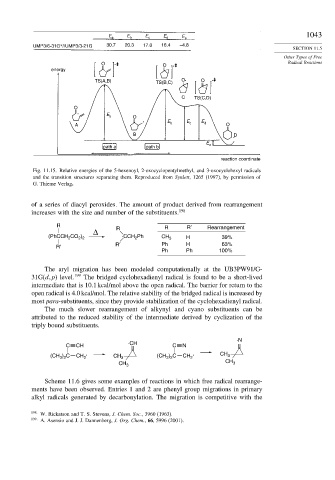Page 1059 - Advanced Organic Chemistry Part A - Structure and Mechanisms, 5th ed (2007) - Carey _ Sundberg
P. 1059
E a E b E c E d E e 1043
UMP3/6-31G∗//UMP3/3-21G 30.7 20.3 17.0 16.4 –4.8
SECTION 11.5
Other Types of Free
O O Radical Reactions
energy
TS(A,B) TS(B,C) O O
C TS(C,D)
O
E a O
E E E
A b c d O
B D
E
path a path b a
reaction coordinate
Fig. 11.15. Relative energies of the 5-hexenoyl, 2-oxocyclopentylmethyl, and 3-oxocyclohexyl radicals
and the transition structures separating them. Reproduced from Synlett, 1265 (1997), by permission of
G. Thieme Verlag.
of a series of diacyl peroxides. The amount of product derived from rearrangement
increases with the size and number of the substituents. 198
R R R R′ Rearrangement
Δ
(PhCCH CO ) . CCH Ph CH 3 H 39%
2 2
2
2
R′ R′ Ph H 63%
Ph Ph 100%
The aryl migration has been modeled computationally at the UB3PW91/G-
31G(d p) level. 199 The bridged cyclohexadienyl radical is found to be a short-lived
intermediate that is 10.1 kcal/mol above the open radical. The barrier for return to the
open radical is 4.0 kcal/mol. The relative stability of the bridged radical is increased by
most para-substituents, since they provide stabilization of the cyclohexadienyl radical.
The much slower rearrangement of alkynyl and cyano substituents can be
attributed to the reduced stability of the intermediate derived by cyclization of the
triply bound substituents.
.N
. CH
C CH C N
(CH ) C CH 2 . CH 3 (CH ) C CH 2 . CH 3
3 2
3 2
CH 3 CH 3
Scheme 11.6 gives some examples of reactions in which free radical rearrange-
ments have been observed. Entries 1 and 2 are phenyl group migrations in primary
alkyl radicals generated by decarbonylation. The migration is competitive with the
198 W. Rickatson and T. S. Stevens, J. Chem. Soc., 3960 (1963).
199
A. Asensio and J. J. Dannenberg, J. Org. Chem., 66, 5996 (2001).

